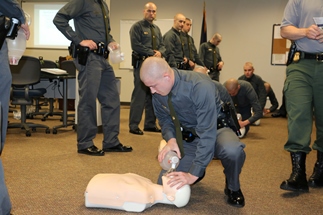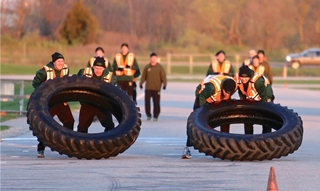Trained to save lives
Week 17: April 24-30
The 17 recruits reported back to the conservation officer academy early Sunday, ready to tackle a volunteer class cleanup project at Lake Interstate located just a mile from the Michigan State Police training facility.
Taking time to volunteer
Lake Interstate, a boat launch established in 1992 and managed by the Michigan Department of Natural Resources, was littered with tires, shingles and trash. The recruits, along with three academy instructors, including Sgt. Jason Wicklund, recruit school commander, spent an hour and a half picking up the litter.
“Anglers, kayakers and walkers using the lake and adjacent land during the cleanup were very happy to see the property cleaned,” Sgt. Wicklund said. “It’s another example of recruits and conservation officers doing what’s necessary to protect Michigan’s natural resources, and that includes volunteering our time. The importance of volunteerism is instilled in the recruits from day one.”
The next class project, a river cleanup, will take place at the beginning of week 19 of the academy.
Up before dawn
Recruits were up before dawn the next morning for an 11-mile, three-hour hike, which began at 4 a.m. Following breakfast, they were in the classroom for the beginning of the week-long first aid and field trauma training.
 First aid and field trauma First aid and field trauma
Conservation Officer Patrick McManus, lead instructor for water safety week, was back at the academy for week 17. CO McManus is the lead DNR Law Enforcement Division first-aid instructor, trainer and coordinator.
Monday morning consisted of classroom instruction on incident stress, the Good Samaritan law, blood-borne pathogens, initial assessments and more.
“Recruits learned to assess the scene and the situation when responding to an emergency,” CO McManus said. “They learned to quickly identify any factor that might hinder them from taking proper care of the victim, such as a busy highway or hostile scene. They learned how to work through obstacles and treat the victim.”
Recruits were also trained on overcoming barriers to act, such as incident stress. “There will be a time when recruits, as conservation officers, see a certain medical situation or traumatic scene for the very first time,” CO McManus said. “They are trained on how to overcome barriers and get the job done, which equates to saving lives.”
The three Cs – check, call, care – will help recruits do just that. Recruits learned to check out the scene and determine what’s happening and what barriers need to be overcome, call for help, and then care for the victim.
After a jam-packed morning, the recruits received even more important lifesaving information in the afternoon. They learned about the basic anatomy and physiology of the human body. They also learned basic medical terminology in order to understand medical personnel when at an emergency scene.
 Recruits also learned about the proper ways to carry patients who are unconscious and those who are conscious. They then practiced those skills, carrying their fellow recruits around the classroom. Recruits also learned about the proper ways to carry patients who are unconscious and those who are conscious. They then practiced those skills, carrying their fellow recruits around the classroom.
Daily quizzes
That evening, recruits studied the many materials they’d learned throughout the day. For the remainder of the week, they’d receive a quiz every morning on lessons learned the day prior. The Tuesday morning quiz included medical terminology, anatomy and much more. At the end of the week, they would take a lengthy final exam.
CPR and AED
All day Tuesday, recruits trained in CPR (cardiopulmonary resuscitation) and AED (automated external defibrillator) use. Unique to Recruit School No. 7, these recruits will be the first to be issued AEDs to carry in their trucks once out in the field. The goal is for every conservation officer in the field to eventually carry this lifesaving device in his or her truck.
 CPR scenario CPR scenario
Recruits also participated in a CPR scenario, running up five flights of stairs to assist an individual (mannequin) in need of CPR. The recruits practiced the three Cs and performed CPR on the adult mannequin.
After the scenario, recruits were assessed by the instructor and then told to leave the room and proceed back to the classroom. However, as they walked down the hallway, another instructor called them into a separate room. Looking around, they saw an unresponsive infant (mannequin). They were told the infant wasn’t breathing.
“This was meant to catch them off guard,” CO McManus said. “They likely decompressed after the first scenario as they headed back to the classroom. This second scenario is designed to teach the recruits to jump into action when they’re least expecting an emergency.”
After the scenario, recruits learned about and practiced the Heimlich maneuver on mannequins, differentiating between adults, children and infants.
 Wednesday morning, recruits were outside for PT, flipping large tractor tires during a 50-yard team relay race. Wednesday morning, recruits were outside for PT, flipping large tractor tires during a 50-yard team relay race.
Injuries
External and internal injury instruction comprised Wednesday morning. During the afternoon, recruits were introduced to the medical equipment available to treat the many types of injuries and taught the proper way to use them. This included wound-packing, use of a tourniquet and more.
They also delved deeper into proper handling of persons with head, neck or spine injuries and chest and abdominal injuries. Recruits dug into their issued first-aid kits, learning in-depth about each component of the kit and how and when to properly use it.
Figuring out the many injuries
Thursday was the day they put it all together. Four scenarios awaited the recruits, each with a different type of injury or medical issue. Recruits moved individually through each station, assessing the scene and situation, calling for help, and identifying and treating injuries or medical issues, all while talking through the process as the instructor stood by, recording their progress and areas in which they needed to improve.
 The first scenario involved a downed conservation officer, shot in the thigh by a suspect. The first scenario involved a downed conservation officer, shot in the thigh by a suspect.
During the second scenario, a maintenance worker, played by Conservation Officer Jill Berry, Recruit School No. 6 graduate, was changing a lightbulb in the hallway when she fell from a ladder that landed on her. She suffered a compound fracture of her arm.
Recruits then individually moved to the third location, inside the exercise room at the Michigan State Police Training Facility, home of the conservation officer academy and where most classroom instruction and scenarios take place. There was a man in exercise gear sitting on the edge of a treadmill. Recruits passed the scenario if they figured out that the man was suffering from heat exhaustion and then properly treated him.
Recruits ran up five flights of stairs to the fifth floor for the final scenario, where they responded to a person (CPR mannequin) lying on the floor of a bedroom and not breathing. The recruit performed CPR and used an AED to resuscitate the individual. View a short video of the scenarios.
Hot and cold emergencies
The remainder of the afternoon focused on heat-induced and hypothermia emergencies. The recruits were first introduced to hypothermic effects during week 15 when they were immersed in an ice bath for four minutes to experience similar effects.
That evening, recruits took an exam on many components of the week. Michigan Commission on Law Enforcement Standards (MCOLES) requires 40 hours of first-aid instruction for all law enforcement officers. The DNR adds to that curriculum, going above and beyond the requirements. In addition, all Michigan conservation officers attend annual four-hour first-aid and CPR training refreshers.
Wilderness survival
Davis Pond Recreation Area was Friday’s destination. Recruits participated in a basic survival class led by Sgt. Joe Kellam of the DNR Law Enforcement Division.
“Should the recruits ever become stranded in the woods overnight, they now have the essential skills and tools to survive their experience,” said Sgt. Wicklund.
Recruits learned how to build temporary shelters out of survival blankets and cords, start a fire without matches, find food, filter water for drinking and much more.
Once they become conservation officers, recruits will have the opportunity to undergo a longer and more extensive wilderness survival training course in the Upper Peninsula, typically held every October.
Recruits then hiked back to the academy and were dismissed for the weekend. Next week, they head north to Camp Grayling for off-road vehicle (ORV) operation and enforcement and fish identification and enforcement training.
Subscribe to the weekly conservation officer academy blog, which also is posted weekly on the Michigan DNR Facebook page. View past blogs from Recruit School No. 7.
# # #
/Photo details: Accompanying photos are available below for download. Caption information follows.
Cleanup project.jpg: This week's class cleanup project included removing trash and debris from around Lake Interstate.
Practicing slings.jpg: Recruits practiced sling techniques by putting them on each other.
Rescue breathing.jpg: Recruits learned the proper way to do rescue-breathing, an important part of CPR.
Moving tires.jpg: Wednesday morning, recruits were outside for PT, flipping large tractor tires during a 50-yard team relay race.
Unconscious infant scenario.jpg: After completing a CPR scenario on an adult mannequin, recruits were caught off guard while heading back to the classroom, when an instructor called them into another room where they completed an unconscious-infant CPR scenario.
First-aid scenarios: Recruits completed four first-aid scenarios Thursday, including a CPR situation./
The Michigan Department of Natural Resources is committed to the conservation, protection, management, use and enjoyment of the state’s natural and cultural resources for current and future generations. For more information, go to www.michigan.gov/dnr.
|


 First aid and field trauma
First aid and field trauma Recruits also learned about the proper ways to carry patients who are unconscious and those who are conscious. They then practiced those skills, carrying their fellow recruits around the classroom.
Recruits also learned about the proper ways to carry patients who are unconscious and those who are conscious. They then practiced those skills, carrying their fellow recruits around the classroom. CPR scenario
CPR scenario Wednesday morning, recruits were outside for PT, flipping large tractor tires during a 50-yard team relay race.
Wednesday morning, recruits were outside for PT, flipping large tractor tires during a 50-yard team relay race.





